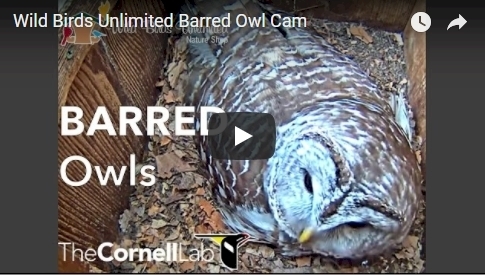Watch Our Barred Owl Nest Cam!
A mama Barred Owl has set up residence in our owl nest box again this year. Jim Carpenter, President & CEO of Wild Birds Unlimited, has hosted a camera-equipped owl box in his backyard for many years and it's time to check in on this year's residents.
Stop by often to watch the live streaming video from TWO CAMERAS at the nest box site 24 hours a day! One camera is placed inside the nest box and one is outside so you can see the owls coming and going.
Click here to access the live stream of Owl Cam and to keep up with this year's timeline of happenings inside the nest box.
WBU Barred Owl Nest Cam
• Jim Carpenter, President & CEO of Wild Birds Unlimited, has hosted a camera-equipped owl box in his backyard since 2010.
• A second outside camera was added in 2018 which allows viewers to see the male and female Barred Owl come and go from the nest box. You will also be able to see the nestlings fledge the box.
• The box has been home to a series of occupants throughout the years, including squirrels and raccoons. Mama Barred Owl claims the box each nesting season.
• She lays two to three eggs around the beginning of March.
• Start looking for the WBU Owl Cam eggs to begin hatching early- to mid-April.
• Watch for the owlets to begin leaving the box early- to mid-May.
• Stop by https://www.wbu.com/owl-cam/ often to watch the live streaming video from the nest box 24 hours a day!
Barred Owl Fun Facts
• Range map obtained from The Birds of North America Online
http://bna.birds.cornell.edu/bna/species/508/articles/introduction
• The Barred Owl is slightly smaller than the Great Horned Owl in size.
• Male and female plumage is identical throughout the year, but females can be about 30% heavier than males.
• Barred Owls maintain their territory throughout the year and are believed to maintain a monogamous pair bond for life.
• Though the size of their territory varies greatly with the type and quality of habitat, a Barred Owl’s home territory is approximately 700 acres.
• The prey (food) of Barred Owls is primarily small mammals, such as squirrels, chipmunks, voles and mice. Barred Owls will also prey in lesser amounts on small birds, amphibians, reptiles and fish.
• Predators of the Barred Owl include Great Horned Owls, Northern Goshawks and climbing mammals such as raccoons and weasels.
• Barred Owls nest only once per year and lay an average of two or three eggs per nesting.
• Only the female incubates the eggs. Incubation lasts for 28-33 days and starts when either the first or second egg is laid.
• The first young to hatch are usually the largest in size with the second and third young being progressively smaller.
• The young will be covered with a fine down and will begin to beg for food a few moments after hatching.
• The female will brood the young almost continually for about two weeks. During this period, the male will deliver all the food for her and the young to the nest.
• The young owls will leave the nest at approximately four to five weeks of age and remain in the branches of the nest tree until they are able to fly at around 10 weeks of age.
• The young owls will stay together with their siblings throughout the summer and are fed by their parents. Then, the young will strike out on their own in early fall when the parents slowly wean them from feedings.
• According to bird banding records, the oldest known Barred Owl living in the wild was at least 24 years old. However, most Barred Owls would be lucky to reach even half this age.


